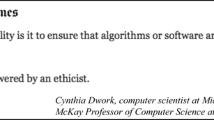Abstract
Peer group analysis is an unsupervised method for monitoring behaviour over time. In the context of plastic card fraud detection, this technique can be used to find anomalous transactions. These are transactions that deviate strongly from their peer group and are flagged as potentially fraudulent. Time alignment, the quality of the peer groups and the timeliness of assigning fraud flags to transactions are described. We demonstrate the ability to detect fraud using peer groups with real credit card transaction data and define a novel method for evaluating performance.
Similar content being viewed by others
References
Bach MP (2003) Data mining applications in public organizations. In: Proceedings of the 25th international conference on information technology interfaces, 16–19 June, pp 211–216
Bhatla TP, Prabhu V, Dua A (2003) Understanding credit card frauds. Whitepaper Tata Consultancy Services
Bolton RJ, Hand DJ (2001) Unsupervised profiling methods for fraud detection. In: Conference on credit scoring and credit control, vol 7, Edinburgh, UK, 5–7 September
Bolton RJ and Hand DJ (2002). Statistical fraud detection: a review. Stat Sci 17(3): 235–255
Brause R, Langsdorf T, Hepp M (1999) Neural data mining for credit card fraud detection. In: 11th IEEE international conference on tools with artificial intelligence, pp 8–10
Callahan PB and Kosaraju SR (1995). A decomposition of multidimensional point sets with applications to k-nearest-neighbors and n-body potential fields. J ACM 42(1): 67–90
Chakrabarti K, Keogh E, Mehrotra S and Pazzani M (2002). Locally adaptive dimensionality reduction for indexing large time series databases. ACM Trans Database Syst 27(2): 188–228
Chan PK, Fan W, Prodromidis AL, Stolfo SJ (1999) Distributed data mining in credit card fraud detection. Intell Syst Appl, IEEE (see also IEEE Intelligent Systems) 14(6):67–74
Fawcett T, Provost F (1999) Activity monitoring: noticing interesting changes in behavior. In: KDD ’99: Proceedings of the fifth ACM SIGKDD international conference on knowledge discovery and data mining, ACM Press, New York, pp 53–62
Ferdousi Z, Maeda A (2006) Unsupervised outlier detection in time series data. In: Proceedings of the 22nd international conference on data engineering workshops, pp 51–56
Guha S, Gunopulos D, Koudas N (2003) Correlating synchronous and asynchronous data streams. In: KDD ’03: Proceedings of the ninth ACM SIGKDD international conference on knowledge discovery and data mining, ACM Press, New York, pp 529–534
Gunopulos D, Das G (2000) Time series similarity measures (tutorial pm-2). In: KDD ’00: Tutorial notes of the sixth ACM SIGKDD international conference on knowledge discovery and data mining, ACM Press, New York, pp 243–307
Hand DJ, Whitrow C, Adams NM, Juszczak P, Weston D (2007) Performance criteria for plastic card fraud detection tools. J Oper Res Soc. http://dx.doi.org/10.1057/palgrave.jors.2602418
Hardin J, Rocke DM (2002) The distribution of robust distances. http://www.cipic.ucdavis.edu/~dmrocke/preprints.html
Jun T (2006) A peer dataset comparison outlier detection model applied to financial surveillance. In: ICPR’06: Proceedings of the 18th international conference on pattern recognition, IEEE Computer Society, Washington, DC, USA, pp 900–903
Kou Y, Lu CT, Sirwongwattana S, Huang YP (2004) Survey of fraud detection techniques. In: IEEE international conference on networking, sensing and control, vol 2, pp 749–754
Maes S, Tuyls K, Vanschoenwinkel B, Manderick B (2002) Credit card fraud detection using bayesian and neural networks. In: Proceedings of the 1st international naiso congress on neuro fuzzy technologies
Murad U, Pinkas G (1999) Unsupervised profiling for identifying superimposed fraud. In: PKDD ’99: Proceedings of the third European conference on principles of data mining and knowledge discovery, Springer, London, pp 251–261
Papadimitriou S, Faloutsos C (2003) Cross-outlier detection. In: Advances in spatial and temporal databases, Springer, Berlin, pp 199–213
Roberds W (1998) The impact of fraud on new methods of retail payment. Federal Reserve Bank of Atlanta Economic Review (First Quarter), pp 42–52
Verboven S and Hubert M (2005). LIBRA: a MATLAB library for robust analysis. Chemom Intell Lab Syst 75: 127–136
Author information
Authors and Affiliations
Corresponding author
Rights and permissions
About this article
Cite this article
Weston, D.J., Hand, D.J., Adams, N.M. et al. Plastic card fraud detection using peer group analysis. ADAC 2, 45–62 (2008). https://doi.org/10.1007/s11634-008-0021-8
Received:
Revised:
Accepted:
Published:
Issue Date:
DOI: https://doi.org/10.1007/s11634-008-0021-8




